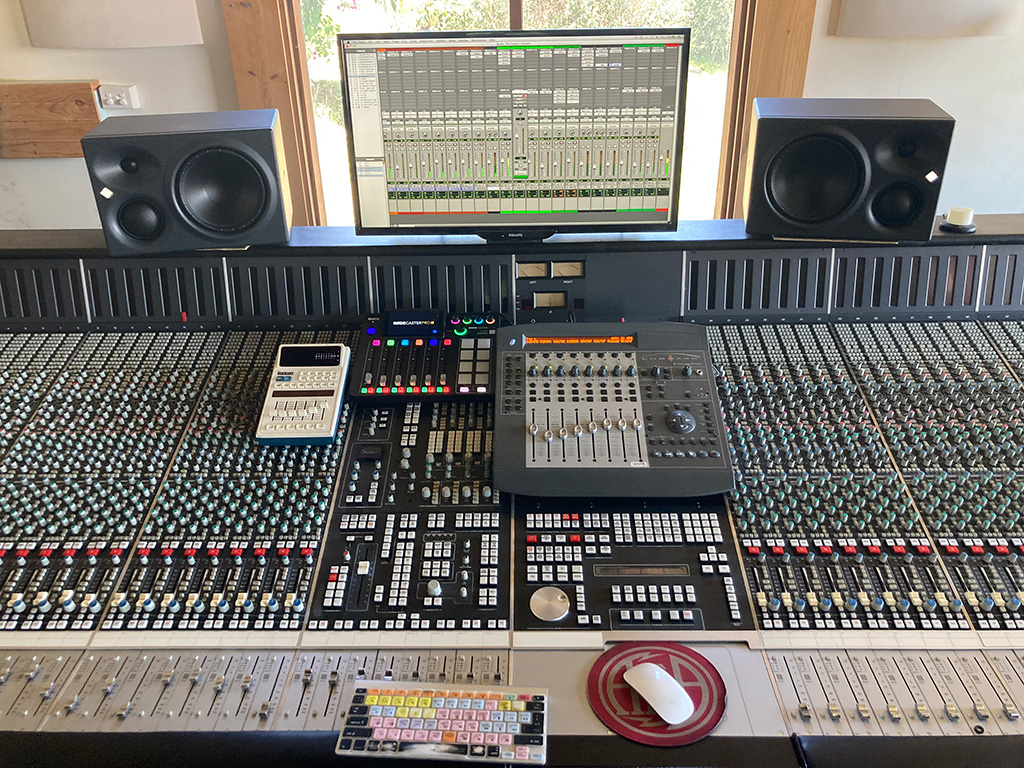LISTEN HERE
10 Mar 2023
CREATIVE MISUSE

Subscribe to CX E-News
Some of the best sounds ever recorded have been the direct result of the creative misuse of audio gear, either intentionally or by accident. Whether it was Geoff Emerick daisy-chaining two preamps together during Beatles sessions to produce unholy distortion, Phil Collins bashing his drums while the talkback mic was open on the SSL console, or even Cher insisting that her AutoTune settings be left to morph her voice into a cyborg, thus creating a new sound and a smash hit, there have been countless examples of cool sounds created in this way littered throughout the history of popular music.
So this issue, I thought we should discuss some of the myriad ways sounds are created using gear in unconventional, incorrect or even downright dubious ways to create something crazy, something cool, something unexpected. I might even try conjuring a sound off the top of my head while I’m writing, to illustrate a particular point: that there’s plenty of ideas out there that remain unmined and unexplored. This is what good sound production is often about: adventure and experimentation, remembering that not everything has been discovered. Not by a long shot! Not by you, at least.
So, in no particular order, here’s a random collection of techniques I’ve developed in isolation over the years whilst trying to solve problems or think outside the square, alongside others that have been shared with me by legends of the industry over a cup of tea or an SSL.
One of the most hilarious (and ironic) examples of creative misuse ever told to me was by legendary engineer and producer Geoff Emerick over breakfast one morning before we were due to talk on stage at a trade show about recording The Beatles. While helping ourselves to far too many serves of bacon and eggs from the breakfast buffet, Geoff imparted the tale of recording ‘Tomorrow Never Knows’ on the very first morning of his new role as head engineer for The Beatles. He had done countless sessions with them beforehand, since their very first session in fact, but never as the head engineer.
Geoff placed a couple of U47 valve mics much closer to Ringo’s drums than had ever been kosher before, dealing with the subsequent dynamics by slamming Abbey Road’s Altec compressors harder than usual. This captured a far wilder, more in-your-face drum sound that amplified the excitement levels of Ringo’s already intense performance. We all do this now, of course!
After the first take Ringo quizzed Geoff by asking him; “What the hell have you done to the drums?” Thinking he was about to be admonished for ballsing up his very first recording session, Geoff attempted to explain what he was trying to capture, only to be interrupted by Ringo who merely wanted to congratulate Geoff for capturing the best drum sound he had ever heard!
When the administration staff of Abbey Road heard about this ‘new technique’, however, Geoff was marched upstairs into the office and roundly criticised for potentially ‘damaging the equipment’. Now of course, the famous studio dines out on these stories daily, thriving off the legacy that Geoff Emerick and his peers established.
Compressors
Compressors feature as a recurring theme in the creative misuse of equipment stakes. The aforementioned ‘Phil Collins drum sound’ is arguably one of the most famous of these, filed under the sub-category: ‘Happy Accidents.’
The story goes that while Hugh Padgham and his assistant Nick Launay were tracking drums with Phil Collins for his hit single ‘In the Air Tonight’, they all stopped momentarily to discuss the drum fills. After a brief chat, and before the talkback mic switch on the SSL console could be unlatched again, Phil let rip with some version of the now iconic drum fill, whereupon the talkback mic compressor on the SSL console initially got slammed, then fought back with huge amounts of compression. Hugh Padgham was so awestruck by the sound of this happy accident that he had the studio techs find a way to patch signal into that compressor, and the rest is history.
(Incidentally, SSL now make this ‘talkback compressor’ available on some of their newer consoles, and even plug-ins, as a ‘cool feature’. Of course, it took a producer, not a console designer, to make this concept cool!)
Technically speaking, compressors are used to control levels, often as transparently as possible, at least from a design standpoint. But many engineers look for the opposite response. We look for distortion, scale, attitude and tone; transparency is often our last concern, especially in the modern world of uber clean digital systems.
We also use compressors to punch holes in other sounds with key inputs, duck reverbs and change the dynamic characteristics of synth pads, even create new instruments altogether out of pads triggered by drums, even when those drums themselves are muted. Want to cut the drums from your track but feel like this shift is just a bit too dramatic for your song arrangement? Try keeping another sound going that pumps in sympathy and time with the original drums, effectively creating a ‘ghost rhythm’ of the original beat.
Distortion
Distortion is probably the other main characteristic of a recorded sound that’s been captured countless times by creatively misusing equipment or by happy accident.
Preamps cranked way too hot and then padded back down with a fader or compressor etc is the obvious one, daisy chaining preamps (mic preamp – line level – mic preamp – line level) is also now another go-to approach for hyper fuzz guitars etc. Just keep a fire extinguisher handy if you’re doing this! Some gear can get hot as a result…
Distortion is one of those things, however, that many of us try to avoid, some of us to a truly masterful degree.
Maybe it’s time you lived a little, cranked an extra 45dB of gain into your favourite preamp and listened to what that does to your vocal, your compressor down the chain, your room mics, that guitar sound. You might make a discovery that sets you on another recording path for the next decade. I did.
Mistakes, Experiments, Trial & Magnificent Error
Try feeding other sounds to your wildest delay on an auxiliary send and see what effect it has on things you originally had no intention of feeding it. Listen through the song; you might find a moment where something magical occurs. Better still, build a crazy aux send out of stuff you normally never think to chain together: a compressor, a backwards delay, a phaser and a widener. Now send sounds to it and see what happens. Sometimes it pays to have no idea what will come of a certain sonic chain.
Flip recorded tracks backwards and throw them back into the track without necessarily trying to arrange them or place them in time. Some of the coolest outcomes occur here without you needing to plan or contrive anything; it’s simply about listening out for a serendipitous moment in the arrangement.
Look for melodic palindromes, things that are the same backwards or forwards, and where they repeat (or even if they don’t) make a backwards copy of the sound and pan it away from the original. Place it later in the timeline so it acts like a cool backwards echo… or just lay it right over the original track as a weird double. The possibilities are endless here.
Try grouping together a bunch of things in a track, and key-input a compressor across that group master so all of them are now under the influence of that gain reduction, off the back of a kick drum or a rhythm guitar etc. Now just listen to the track again with half the song pumping weirdly in unexpected ways. Don’t like it? Okay then. What does it sound like if you simply change the key input to something else?
A New Sound – For My Next Mix Perhaps
To my plan of inventing a sound as I write.
I imagine getting a backing vocal or two and feeding both these sounds to three aux sends each (I’m gonna do this because the tracking is finished and I’ve suddenly decided the BVs sound ho- hum). Each auxiliary will have a pitch shifter and pitch controller on the insert chain, followed by a chorus and a long reverb of some description set to 100% wet.
What I want to achieve here is a sense of BV harmonies (thirds, fifths, octaves… whatever) behind the main harmonies acting as distant ‘harmonic cellophane’ to the background vocals (backgrounds to the background, as it were). All of them will have different variations on the pitch control and chorus setting, and I suspect the sound I’ll get back will be harmonic, phasey and fizzy… and distant. I want a sense of harmony, but nothing solid or dense… a whisper of a harmonic reverb tail only…. might work. Might suck.
Now it’s your turn. Go into the studio wherever you work: do something you never think to do, or would normally never do, and just listen to the outcome. Importantly, don’t give up the hunt in five minutes. Be patient… and persistent. If you hit on something, write to me (or the mag) and let us all know what you’ve discovered. And if someone says: “Oh actually that was done by Fred 20 years ago on the album Blah Blah Blah… who cares?! You don’t have to own it, just like it!

Andy Stewart owns and operates The Mill in Victoria. He’s always trying to get studio professionals to think outside the box, beyond their comfort zone. Are you up for the challenge?
Subscribe
Published monthly since 1991, our famous AV industry magazine is free for download or pay for print. Subscribers also receive CX News, our free weekly email with the latest industry news and jobs.






